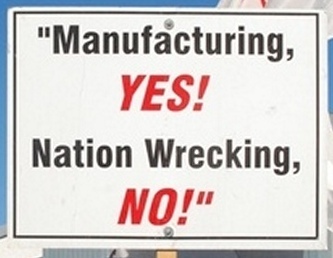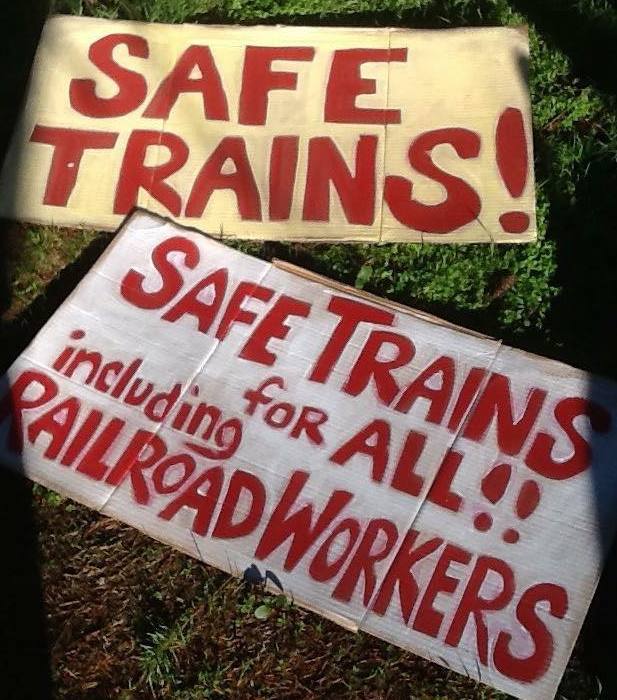|
October 8, 2020 - No. 68
Auto Workers Approve New Collective Agreement with Ford
Another Pay-the-Rich Scheme to Restructure the Auto Industry
- Louis Lang -  
• New Collective Agreement
Concerns of Rail Workers for Their Safety and Their Right to Privacy
• Interview with Lyndon Isaak
Auto Workers Approve New Collective Agreement with Ford
- Louis Lang -

Autoworkers
rally in Oshawa following announcement that GM was planning to close
the Oshawa assembly plant, November 26, 2018, calling for the company
to reverse its decision.
On September 28, auto workers employed by Ford Motor Company
voted 81 per cent in favour of a three-year collective agreement
covering the company's plants in Windsor and Oakville. It is clear that the goal of the Ford
monopoly in signing the new collective agreement with Unifor is to
ensure that the production of automobiles in Canada remains "business
as usual." In this case it means continuing to receive vast amounts of state funds to finance its operations. It also
means further integrating the
Canadian economy into the U.S. imperialist war economy.
This method has been in place for more than 50 years since the
signing of the Auto Pact by the Pearson Liberals. Despite
never-ending profits for the three main monopolies, recurring crises
and insecurity for auto workers and the communities in which the plants
are located is a constant because the Canadian economy is neither
independent nor geared to ensuring the well-being of the working
people. In addition to domination by North American monopolies through
the Canada-United States-Mexico Agreement, the auto industry is also
subject to the Comprehensive and Progressive Agreement for
Trans-Pacific Partnership, the Canada-Korea Free Trade Agreement and
the Canada-European Union Comprehensive Economic and Trade
Agreement.
The investment by Ford, more than a quarter of which will be covered
by government pay-the-rich schemes, is intended to position Ford in the
production of battery electric vehicles (BEVs), ahead of its
competitors in Japan, China and Europe, as well as Tesla. It will not
address the problem of job security for auto workers or of the need for
an independent and self-reliant Canadian economy.
The auto industry in Canada is much more than the five global auto
monopolies -- Toyota, GM, Honda,
Fiat-Chrysler and Ford -- which dominate the Canadian scene as the main builders of
vehicles. Automotive parts suppliers operate more than 700 manufacturing plants in Canada. Of
those a few are large Canadian suppliers that operate globally
(e.g. Magna International, Linamar, Martinrea, Woodbridge, etc.). There
are also Canadian subsidiaries of large Japanese, European and U.S. global suppliers as well as medium, small and
single-establishment Canadian parts suppliers.[1]
 The
ongoing restructuring by the big three North American monopolies,
especially since the 2008-09 financial crisis, has resulted in many
plant closures such as the closure of the GM plant in Oshawa as well as
several other assembly plants in Michigan and Ohio. These closures also
put in jeopardy the livelihoods of thousands of workers in the
automotive parts industry which serves the entire Great Lakes Region
where the auto industry has historically been concentrated. The
ongoing restructuring by the big three North American monopolies,
especially since the 2008-09 financial crisis, has resulted in many
plant closures such as the closure of the GM plant in Oshawa as well as
several other assembly plants in Michigan and Ohio. These closures also
put in jeopardy the livelihoods of thousands of workers in the
automotive parts industry which serves the entire Great Lakes Region
where the auto industry has historically been concentrated.
In their negotiations with monopolies like Ford, workers keep in
mind the objective conditions in which they find themselves and their
past experience. One inescapable conclusion they draw when negotiations
take place and deals are struck is that a leopard does not change its
spots.
In these negotiations Ford openly said, "Pay us, be our partner,
help us become competitive in the international market" and you will
keep your jobs. This has led to more and more demands for concessions
from workers and for more funds from governments as the auto monopolies
keep upping the ante to make profits. As long as this arrangement
continues, the problems of the industry and society cannot be solved.
Auto workers are confronted with the ongoing need to change the
direction of the economy which is based on looking after the interests
of the rich first. This cannot be the aim of a society which is capable
of meeting the needs of its members.
Note
1. The Future of the Canadian Auto Industry, Canadian Centre for Policy Alternatives, 2019, p. 6.

The new collective
agreement signed between Ford and Unifor includes commitments from the company for total investments of $1.95
billion. This includes $148 million for the building of a new engine
at the Windsor operations and $1.8 billion to retool the Oakville
assembly plant to produce battery electric vehicles (BEVs). The retool
is scheduled to begin in 2024 with the first BEV to roll off the
assembly line in 2026.
A letter from Ford's Vice-President of Human Resources to Unifor's
National President summarizes the investments the company intends to
make in Windsor-Essex and Oakville and also confirms the commitment
which was required from the union to work in partnership with the
company to ensure that Ford remains competitive in the auto
industry. The letter concludes as follows; "Accordingly, the union
agreed that it would partner with the company to approach provincial
and federal governments to obtain financial incentives that will
support the business case and contribute to the success of this vision
as set out in the letter."
In line with the demands of the Ford monopoly, even as negotiations
between Unifor and Ford continued, the federal government announced
its $500 million contribution to help Ford "produce electric vehicles." The
Ontario government has yet to make any statement about the extent of
their financing of the retooling of the Ford plant.
Excerpts from the Collective Agreement
Wages:
1) 2.5 per cent increase effective September 28, 2020;
2) instead of a wage increase in the
second year, there will be a lump sum payment of 4 per cent of earnings
from the previous 12 months, effective September 27, 2021; and
3) 2.5 per cent wage increase in the third year effective September 26, 2022.
Adjustments to the two-tier wage system for new hires:
A newly hired worker, instead of receiving 61.25 per cent of the
2012 base rate, as is currently the case, will receive 65 per cent of
the prevailing rate. The new contract also provides that new hires can
reach the prevailing rate in eight years instead of the ten years
required by the previous contract.
A full summary of the collective agreement is available here.

Concerns of Rail Workers for Their Safety and Their Right to Privacy
 Lyndon Isaak is the President of the Teamsters Canada Rail Conference (TCRC).
Workers' Forum: In your September report posted on the
TCRC website, you raise several concerns of rail workers, two of them
being safety during the pandemic and the right to privacy. Can you
brief us on what these concerns are and the demands of workers to
address them?
 Lyndon Isaak:
Basically the concern is over the relaxation of the protocols we put in
place to keep the bunkhouses and rest facilities safe and
disinfected. Another important concern for us is the need for continued
disinfection of the locomotives and vehicles used to transport
railway workers to and from the trains. In the
beginning, back in April and May, the railways shared our concerns about
COVID. They were cooperative with us in keeping places clean and
sanitized. But now they feel that the pandemic is over and they have
started to relax their protocols. They were vigilant for the first few
months, but now they have lost interest in being vigilant. For
example, in the beginning, contractors were hired to clean locomotives
at crew trade-off locations. Let us say the train is going from Toronto
to Montreal and halfway between Toronto and Montreal we trade crews.
They had contractors there to keep locomotives clean and sanitized.
They no longer have them so now it is up to our crews
themselves to sanitize and clean locomotives in these locations. That
is one example. Lyndon Isaak:
Basically the concern is over the relaxation of the protocols we put in
place to keep the bunkhouses and rest facilities safe and
disinfected. Another important concern for us is the need for continued
disinfection of the locomotives and vehicles used to transport
railway workers to and from the trains. In the
beginning, back in April and May, the railways shared our concerns about
COVID. They were cooperative with us in keeping places clean and
sanitized. But now they feel that the pandemic is over and they have
started to relax their protocols. They were vigilant for the first few
months, but now they have lost interest in being vigilant. For
example, in the beginning, contractors were hired to clean locomotives
at crew trade-off locations. Let us say the train is going from Toronto
to Montreal and halfway between Toronto and Montreal we trade crews.
They had contractors there to keep locomotives clean and sanitized.
They no longer have them so now it is up to our crews
themselves to sanitize and clean locomotives in these locations. That
is one example.
Also, during the first few months, they allowed only two people in
the locomotive cab and now they are training again and they have three
people in there. We have an issue with that because of the need for
physical distancing and because of the airborne nature of the virus.
They
are saying that they are going to run out of manpower and that
they have to train people. They think that they are not going to have
enough manpower to keep the trains going full tilt. We want to find a
way around having three workers in the cab, which is a confined space,
because if one is infected, by the end of 10 to 12 hours together they
are all going to be infected. We have not been able to come to an
agreement with the railways on a solution. The problem has not been
solved yet. And now that the second wave is upon us, we think that
sooner or later there is going to be an infection that spreads through
the railways if we don't put an end to this relaxation of protocols. We
want to avoid that. The pandemic has been kept under control quite
well so far. That is our point; we have been successful so far, so now
is not the time to relax protocols.
We want the railways to revert back to the protocols that we
established jointly in April and we also want to make sure that these
protocols are being followed in the field. It is one thing to agree to
something, but it is another thing if the frontline officers are not
informed by the rail companies about the protocols that have been
agreed upon.
This is happening a lot. Among other problems, there is a lack of
communication in the system.
We still have weekly calls with the large railways to try and
resolve these issues but they are resisting the reestablishment of the
former protocols.
There are financial costs involved in these protocols. There is a
slight reduction in productivity and their boards of directors and the
owners of their stock want maximum return all the time, so they are
willing to gamble. That is called risk management. As long as they keep
their profits up, they are going to gamble with the workforce. We are
strongly opposed to that.
 WF: In
your report, you also raise concerns over the use of locomotive voice
and video recorders (LVVR). In May 2018, the federal government
passed Bill C-49, An Act to amend the Canada Transportation Act and
other Acts respecting transportation and to make related and
consequential amendments to other
Acts. Among other things, the Act orders rail companies of a
certain size in terms of revenues and number of employees to ensure
that an LVVR system is installed in every controlling locomotive they operate, to record
everything said and have an unobstructed view of faces and upper
bodies. The unions have opposed this from the start. Can you tell us
more about
it? WF: In
your report, you also raise concerns over the use of locomotive voice
and video recorders (LVVR). In May 2018, the federal government
passed Bill C-49, An Act to amend the Canada Transportation Act and
other Acts respecting transportation and to make related and
consequential amendments to other
Acts. Among other things, the Act orders rail companies of a
certain size in terms of revenues and number of employees to ensure
that an LVVR system is installed in every controlling locomotive they operate, to record
everything said and have an unobstructed view of faces and upper
bodies. The unions have opposed this from the start. Can you tell us
more about
it?
LI: Our opposition is to the companies' having access to the
LVVR data, to the content of the recordings. We believe that only the
Transportation Safety Board should have access to the content. We do
not believe that it is going to serve any useful purpose for the
corporations to have that access and have said that all along. We
received assurances when the bill was passed that the government would
address our concerns with the regulations but they did not.[1]
If you read the regulations that have been published in the Canada Gazette,
Part II, on September 2, you see that the companies basically have
unfettered access to the data. The wording is still there that there
should be random access for the railways to the content but nobody is
going to be able to police that. There is no information that
they can glean from that access that is going to be helpful in any way.
The only way they will use the information is for discipline. That
is the aim
behind it. Not only is it going to be used for discipline but they are
going to pick and choose who they want to discipline. If they do not
like a specific crew, that is the crew they are going to watch 24/7.
As I said in my report, now that both the Act and the regulations
are finalized, and the intent is defined, we can proceed with our legal
challenge in front of the Supreme Court on the constitutionality of
this legislation. According to us, this legislation not only infringes
on the rights and freedoms of our membership but sets precedents that
could diminish the rights of all Canadians.
WF: Do you want to say something in conclusion?
LI: I hope that everybody is going to follow the
Health Canada guidelines and stay safe in the second wave of the
pandemic. I hope that all corporations, including the railways, will
come to terms with the fact that the most stringent protocols are the
most appropriate at this time and are the ones that they should
utilize. We
are fighting for that and hopefully we will prevail.
Note 1. According to Bill C-49, the
information from the recording is to be used to determine causes of and
contributing factors to accidents or incidents on the railways. The
large rail companies have already made it clear that they consider
workers' inappropriate "behaviour" to be the main cause of rail
accidents, against all evidence which points to lack of healthy and
safe working conditions. During the parliamentary hearings on the bill
before it passed, the representative of the Railway Association of
Canada went so far as to say that as long as all the processes in the
railways are not "fully automated" there are going to be accidents
because of human factors, meaning the workers. Rail workers have been
fighting for years for improvements to fatigue-inducing conditions
including lack of predictable schedules forcing workers to be on-call
for extended periods, long hours of work, crew shortages,
etc.
The Act also includes the concept of threat to safety of railway
operations to justify giving companies access to the content of the
recordings so as to address a perceived threat. The regulations
identify eight threats to the safety of operations, all of them from
workers. Those are:
- a worker who uses a cellular telephone while on duty when normal railway radio communication systems are available;
- a worker who "assumes a sleeping position while on duty;"
- a worker who uses a personal entertainment device while on duty;
- the presence of an unauthorized person in the controlling locomotive;
- a worker who is consuming or using intoxicants or impairing drugs;
- a worker who reads materials not required in the performance of their duties while on duty; and
- workers who are within hearing range of
each other but who are not verbally communicating, in a clear and
audible manner, information they are required to verbally communicate
in accordance with rules approved or established by the Minister of
Transport.
The legislation uses the dramatic term "threat" in characterizing
actions of workers to justify the increased repression and
criminalization of workers that the companies are seeking.

(To access articles individually click on the black headline.)
PDF
PREVIOUS
ISSUES | HOME
Website: www.cpcml.ca
Email: office@cpcml.ca
|

